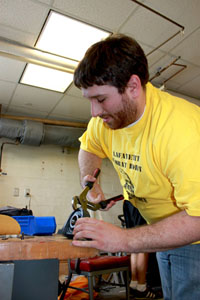A team of mechanical engineering seniors will compete at RoboGames in California
Twelve senior mechanical engineering majors are getting ready to do battle–robotic battle, that is. They have designed a tactical combat robot (TCR) as a senior capstone project and will compete in the seventh annual RoboGames in San Mateo, Calif., April 23-25.
 “The [capstone] projects provide an experience comparable to the kind of projects an engineer would find in a professional setting,” says project manager Michael Fuller (Concord, N.H.). “We have to deal with more than just the engineering of the project. The personal team dynamics and constraints on time and resources play a factor, and our team project allowed us to experience that.”
“The [capstone] projects provide an experience comparable to the kind of projects an engineer would find in a professional setting,” says project manager Michael Fuller (Concord, N.H.). “We have to deal with more than just the engineering of the project. The personal team dynamics and constraints on time and resources play a factor, and our team project allowed us to experience that.”
The team includes Kyle Basting (Dover Plains, N.Y.), William Booz (Durham, Conn.), Zachary Cleary (South Glastonbury, Conn.), Frederick Denton (Woods Hole, Mass.), Jason Jones (Easton, Pa.), Matthew Lick (Easton, Pa.), Amy Mickiewicz (Tolland, Conn.), Alex Plant (Milton, Mass.), Colin Smith (Renton, Wash.), Justin-Elliot Vanier (Rolling Hills, Calif.), and Christopher Wowk (Trumbull, Conn.). Steven Nesbit, professor of mechanical engineering, is the team’s adviser, and Kevin Farrell, engineering technician, provided manufacturing expertise. Serena Ashmore, department secretary, has helped the team with various administrative tasks related to the competition.
A TCR is a remotely operated vehicle that is completely controlled by team members. It will battle against other similarly designed robots in the 120-pound division of the RoboGames, encountering obstacles like vertical or horizontal spinning weapons such as hammers, hatchets, clamps, or saws. Each round of the competition begins with two TCRs squaring off in a 25-foot by 25-foot steel-floored arena surrounded by spikes. The goal for each team is to destroy the opposing TCR, but they will receive points for damage inflicted on another team’s device. The winner has a limited time to make necessary repairs before moving on to the next round.
Each team member is responsible for a certain aspect of the TCR’s creation. Some are handling design challenges covered in courses on statics, dynamics, instrumentation and data acquisition, and design. Students managing pneumatics are relying on knowledge they gained in the fluid mechanics course. The electronics team has relied on systems and controls classes. Lessons from the failure modes course, which some students are taking this semester, have come in handy in choosing materials and focusing some design decisions based on historical mistakes.
For Fuller, who plans to pursue a master’s degree in mechanical engineering after graduation, the project ties together everything he’s learned during his undergraduate years. It’s proof he’s received a top-notch education with facilities typically reserved for students on the graduate level.
“The tactical combat robot encompasses much of what we’ve learned in our four years of mechanical engineering at Lafayette. A mechanical engineering student takes about 22 engineering classes. These, in addition to advanced math and science courses, inform most, if not all, actions taken by members of the team,” says Fuller. “Engineering is not just memorizing equations; it’s a way of thinking. Engineering of any specific discipline is a way of analyzing a problem using past knowledge and current data to determine both a feasible, real-world solution and the methodology to put that solution into action.”
 “The [capstone] projects provide an experience comparable to the kind of projects an engineer would find in a professional setting,” says project manager Michael Fuller (Concord, N.H.). “We have to deal with more than just the engineering of the project. The personal team dynamics and constraints on time and resources play a factor, and our team project allowed us to experience that.”
“The [capstone] projects provide an experience comparable to the kind of projects an engineer would find in a professional setting,” says project manager Michael Fuller (Concord, N.H.). “We have to deal with more than just the engineering of the project. The personal team dynamics and constraints on time and resources play a factor, and our team project allowed us to experience that.”